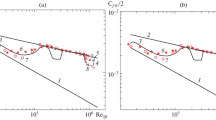Abstract
Steady turbulent viscous incompressible fluid flow in a plane channel is calculated for the case of uniform blowing and suction through opposite walls. There are no experimental data for flows of this type. The flows were calculated by two methods: a direct numerical simulation method and using a three-parameter turbulence model. Direct numerical simulation was carried out using the same (apart from the boundary conditions) algorithm for numerical solution of the Navier-Stokes equations as that used earlier for calculating flows in pipes and channels with impermeable walls. In the second group of calculations the version of the model published in 1978 was used. The results obtained by the two methods are in good agreement. The difference is within the spread of the experimental data used for determining the parameters of the model. The agreement obtained makes it possible to assert that the turbulence direct numerical simulation algorithm developed can be used for the analysis of flows with quite different boundary conditions, including cases where there are no corresponding experimental data.
Similar content being viewed by others
References
J. Kim, P. Moin, R. Moser, “Turbulence statistics in fully developed channel flow at low Reynolds number,” J. Fluid Mech.,177, 133–166 (1987).
P. R. Spalart, “Direct simulation of a turbulent boundary layer up to Re6=1410,” J. Fluid Mech.,187, 61–98 (1988).
V. G. Prijmak, “Results and possibilities of direct numerical simulation of turbulent flows of viscous fluid in a circular pipe,” Doklady AN SSSR,316, No. 1, 71–76 (1991).
J. G. M. Eggels, F. Unger, M. H. Weiss et al., “Fully developed turbulent pipe flow: a comparison between direct numerical simulation and experiment,” J. Fluid Mech.,268, 175–209 (1994).
N. V. Nikitin, “Direct numerical simulation of three-dimensional turbulent flow in pipes of a circular cross-section,”Izv. RAN, Mekh. Zhidk. i Gaza, No. 6, 14–26 (1994).
N. V. Nikitin, “Statistical properties of near-wall turbulence,”Izv. RAN, Mekh. Zidk. i Gaza, No. 3, 32–43 (1996).
N. V. Nikitin, “Spectral-finite-difference method of calculating turbulent flows of incompressible fluid in pipes and channels,”Zhurn. Vych. Matem. i Mat. Fiziki,34, No. 6, 909–925 (1994).
N. V. Nikitin, “Spatial approach to numerical simulation of turbulence in pipes,” Doklady RAN,343, No. 6, 767–770 (1995).
N. V. Nikitin, “Numerical simulation of turbulent flows in ducts of square cross-section,” Doklady RAN,353, No. 3, 338–342 (1997).
V. G. Luschik, A. A. Pavel’ev, A. E. Yakubenko, “Three-parameter model of shear turbulence,”Izv. AN SSSR, Mekh. Zhidk. i Gaza, No. 3, 13–25 (1978).
V. G. Luschik, A. A. Pavel’ev, A. E. Yakubenko, “Control of turbulent boundary layers: experimental results and calculation models,” in:Mechanics and Progress in Science and Technology, V.2,Fluid Mechanics. Nauka, Moscow, 67–89 (1987).
V. G. Luschik, A. A. Pavel’ev, A. E. Yakubenko, “Transport equation for characteristics of turbulence: models and calculation results,” in:Results of Science and Technology. Ser. Fluid Mechanics. V.22, VINITI, Moscow, 3–61 (1988).
V. G. Luschik, A. A. Pavel’ev, A. E. Yakubenko, “Turbulent flows. Models and numerical studies,”Izv. RAN, Mekh. Zhidk i Gaza, No. 4, 4–27 (1994).
A. A. Antonia, L. Fulachier, “Topology of a turbulent boundary layer with and without wall suction,” J. Fluid Mech.,198, 429–451 (1989).
M. Schildknecht, J. A. Miller, G. E. A. Miller, “The influence of suction on the structure of turbulence in fully developed pipe flow,” J. Fluid Mech.,90, Pt. 1, 67–107 (1979).
P. Moin, “Numerical simulation of wall-bounded turbulent shear flows,” in:Proc. 8th Intern. Conf. Numer. Methods in Fluid Dynamics, Ed. E. Krause, Springer, N.Y., 55–76 (1982).
U. Pionelly, J. Ferziger, P. Moin, J. Kim, “New approximate boundary conditions for large eddy simulations of wall-bounded flows,” Phys. Fluids,A1, No. 6, 1061–1068 (1989).
P. Mariani, P. Spalart, W. Kollmann, “Direct simulation of a turbulent boundary-layer with suction,” in:Int. Conf. on Near-Wall Turbulent Flows. Ed. R.M.C.So et al., Elsevier, Amsterdam, 347–356 (1993).
Y. Sumitani, N. Kasagi, “Direct numerical simulation of turbulent transport with uniform wall injection and suction,” AIAA Journal,33, No. 7, 1220–1228 (1995).
R. B. Dean, “Reynolds number dependence of skin friction and other bulk flow variables in two-dimensional rectangular duct flow,” Trans. ASME. I: J. Fluid Engng,100, No. 2, 215–223 (1978).
R. L. Simpson, R. J. Moffat, W. M. Kays, “The turbulent boundary layer on a porous plate: experimental skin friction with variable injection and suction,” Intern. J. Heat and Mass Transfer,12, No. 7, 771–789 (1969).
A. K. M. F. Hussain, W. C. Reynolds, “Measurements in fully developed turbulent channel flow,” Trans. ASME I: J. Fluid Engng.97, No. 4 568–580 (1975).
Additional information
Moscow. Translated from Izvestiya Rossiiskoi Akademii Nauk, Mekhanika Zhidkosti i Gaza, No. 6, pp. 18–26, November–December, 1998.
The work was financially supported by the Russian Foundation for Basic Research (project Nos. 96-01-00602 and 96-01-00259).
Rights and permissions
About this article
Cite this article
Nikitin, N.V., Pavel’ev, A.A. Turbulent flow in a channel with permeable walls. Direct numerical simulation and results of three-parameter model. Fluid Dyn 33, 826–832 (1998). https://doi.org/10.1007/BF02698650
Received:
Issue Date:
DOI: https://doi.org/10.1007/BF02698650



